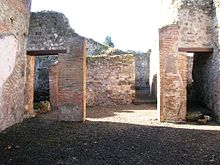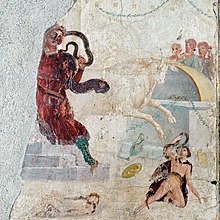Casa di Laocoonte
The Casa di Laocoonte ("House of Laocoon") is a house in the city of Pompeii, which was buried in the year 79 AD when Mount Vesuvius erupted . It got its name from a mural there depicting the Laocoon . The house was excavated in 1875.
The Casa di Laocoonte is located in the district of Pompeii, which is now known as Region VI , and there on plot 14, where the entrances are numbered 28 to 31 (VI 14, 28-31 for short). It is a very old building that was rebuilt after the earthquake in AD 62. The facade consists of opus testaceum . A left side room was the shop (taberna argentaria) of the money lender Faustilla, on the right there was a cubiculum (side room of an atrium). The atrium tuscanicum including the cistern had no other side rooms, on the right there was a passage to the stable and a staircase to the upper floor. On the left was a garden with a gutter and well, on the right of the garden the kitchen and the triclinium . To the west there is a passage to a bakery with three mills and an oven that was decorated with a phallus . The house is particularly known for its wall paintings in the third style (up to approx. 50 AD).
The most famous, albeit partially destroyed, mural from the atrium of the house shows the Laocoon clad in a chiton and wreathed. He seeks protection from a snake on the steps of an altar, which attacks him. One of his sons is also attacked by a snake, the second lies killed on the ground. A bull and four spectators are shown in the background. The mural is now in the National Archaeological Museum of Naples (inventory number 111210) and may be dependent on the Laocoon group . A reference to Virgil's Laocoon depiction in the second book of the Aeneid was initially rejected in research, Rudolf Ehwald rather saw a source in Euphorion's work and the altar as part of a temple - probably of Apollon Tymbraios. Recently, research has assumed a reference to Virgil, since this is probably the first time all three people have died; it is also assumed that the work is only a copy. The counterpart to the Laocoon in the neighboring triclinium is a mural of Polyphemus and Aeneas with his companions (now Naples, National Archaeological Museum, inventory number 111211), which Odysseus may also belong to. Furthermore, murals with Cupid , Bacchus and Mercurius as well as several animals and people, including women with garlands, a hetaera , children and lovers, have been found in this house. In addition to portraits also could vases , cupids, topography and Amazons - shields , cups and a Lararium be identified.
literature
- Richard Foerster , On the origin of the Laocoon. In: Negotiations of the fortieth meeting of German philologists and schoolmen in Görlitz from October 2nd to 5th, 1888 . Leipzig 1890, pp. 90-91.
- Rudolf Ehwald : Virgilian comparisons. In: Philologus . 53, 1894, pp. 729–744 (on the Laocoon mural, pp. 740–743 archive.org ).
- Karl Schefold : The walls of Pompeii. Topographical directory of the image motifs. Berlin 1957, pp. 134-135.
- Matthias Winner : On the afterlife of the Laocoon in the Renaissance. In: Yearbook of the Berlin museums. 16, 1974, pp. 87-88.
- Erika Simon : Laocoon . In: Lexicon Iconographicum Mythologiae Classicae (LIMC). Volume VI, Zurich / Munich 1992, p. 198.
- Liselotte Eschebach (ed.), Hans Eschebach : Directory of buildings and city map of the ancient city of Pompeii. Böhlau, Cologne / Weimar / Vienna 1993, ISBN 3-412-03791-5 , pp. 214-215.
- Pompei. Pitture e Mosaici. Volume 5, Rome 1994, pp. 341-362 (with numerous illustrations and extensive bibliography).
Web links
- Views of the house
- Drawings from the 18th and 19th centuries after wall paintings in the Casa di Laocoonte
Coordinates: 40 ° 45 ′ 7.6 ″ N , 14 ° 29 ′ 7.5 ″ E

